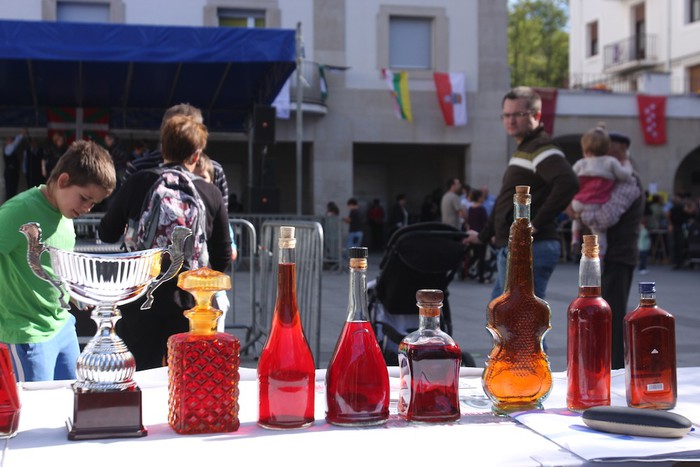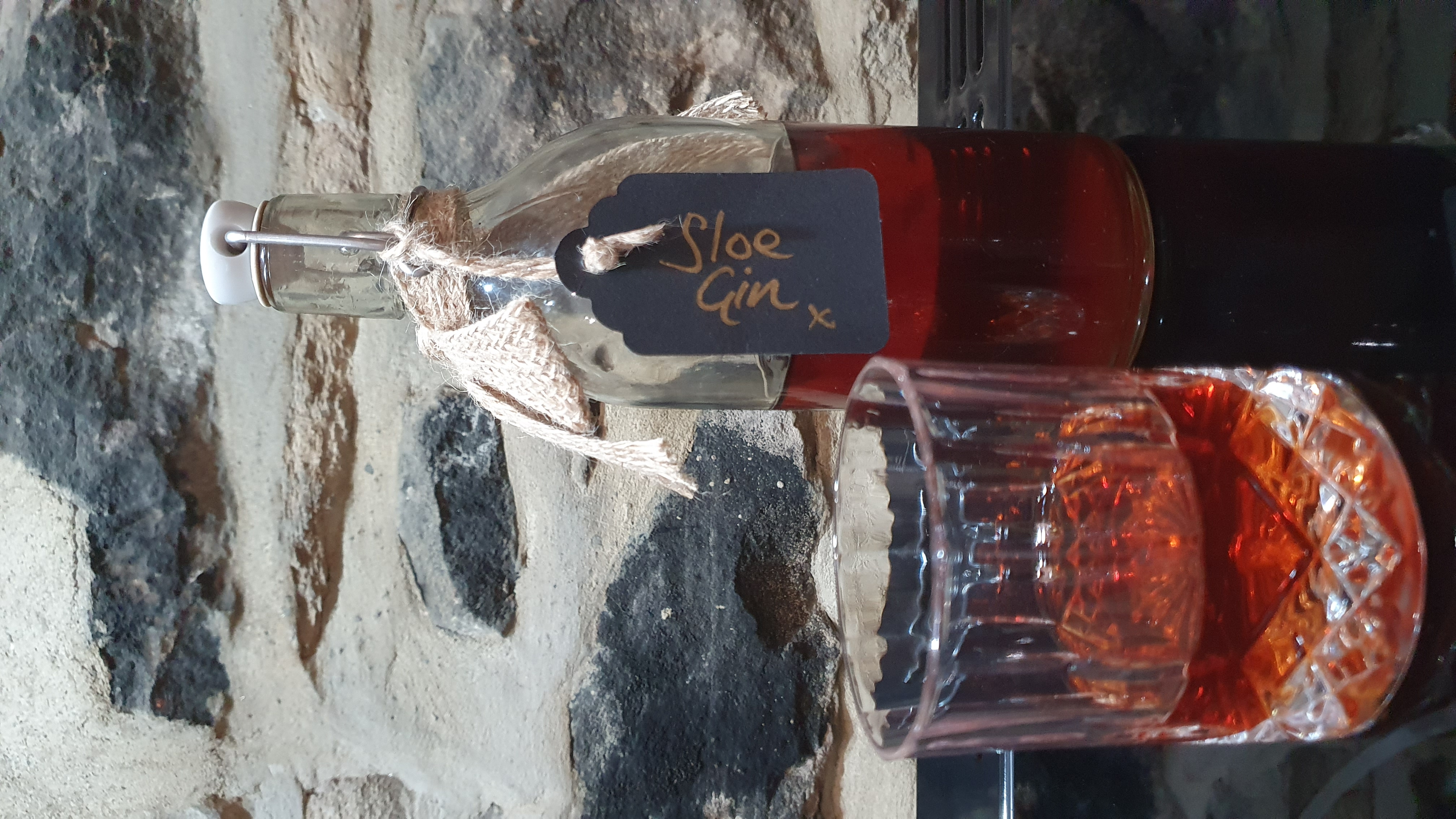|
Patxaran
Patxaran (; ) is a sloe-flavoured liqueur commonly drunk in Navarre, as well as in the Basque Country (greater region), Basque Country. It is usually served as a digestif either chilled or on ice. Etymology The word ''patxaran'' is the Upper Navarrese dialect, Upper Navarrese form of ''basaran'', from Basque ''basa'' 'wild' and ''aran'' 'sloe'. It also occurs in the various Basque dialects as ''baxaran'', ''basarhan'', ''baixaran'' and various other forms. Process Patxaran is made by soaking sloe fruits, collected from the Prunus spinosa, blackthorn shrub, along with a few coffee beans and a cinnamon stick in anisette, for one to eight months. The process produces a light sweet reddish-brown liquid around 25-30% in alcohol content by volume. In addition to dictating the amount of sloes to be used, the regulating body for Pacharán Navarro insists that no artificial colourings or flavourings be added and that the Maceration (wine), maceration last between one and eight months. H ... [...More Info...] [...Related Items...] OR: [Wikipedia] [Google] [Baidu] |
Sloe Gin
Sloe gin is a British red liqueur made with gin and Prunus spinosa, blackthorn fruits (sloes), which are the drupe fruit of the ''Prunus spinosa'' tree, which is a relative of the plum. As an alcoholic drink, sloe gin contains between 15 per cent and 30 per cent alcohol by volume (ABV); however, European Union regulations established 25 per cent ABV as the minimal alcoholic content for the blackthorn beverage to be a ''sloe gin''. Historically, despite being a liqueur based upon gin, the EU included the colloquial name ''sloe gin'' to the legal definitions; thus, sloe gin is the only alcoholic beverage that legally uses the term ''gin'' without appending the ''liqueur'' suffix. The traditional method of preparation of sloe gin is to soak the blackthorns (sloes) in gin with some sugar, and the mixture sweetens when the blackthorn fruit mature in the alcohol. Commercial sloe gin is made by flavouring an inexpensive neutral grain spirit. US distilleries use close fruits related to ... [...More Info...] [...Related Items...] OR: [Wikipedia] [Google] [Baidu] |
Sloe
''Prunus spinosa'', called blackthorn or sloe, is an Old World species of flowering plant in the rose family, Rosaceae. It is locally naturalized in parts of the New World. The fruits are used to make sloe gin in Britain and patxaran in Basque Country. The wood is used to make walking sticks, including the Irish shillelagh. Description ''Prunus spinosa'' is a large deciduous shrub or small tree growing to tall, with blackish bark and dense, stiff, spiny branches. The leaves are oval, long and broad, with a serrated margin. The flowers are about in diameter, with five creamy-white petals; they are produced shortly before the leaves in early spring, and are hermaphroditic, and insect-pollinated. The fruit, called a "sloe", is a drupe in diameter, black with a purple-blue waxy bloom, ripening in autumn and traditionally harvested – at least in the UK – in October or November, after the first frosts. Sloes are thin-fleshed, with a very strongly astringent flavour wh ... [...More Info...] [...Related Items...] OR: [Wikipedia] [Google] [Baidu] |
Prunus Spinosa
''Prunus spinosa'', called blackthorn or sloe, is an Old World species of flowering plant in the rose family, Rosaceae. It is locally naturalized in parts of the New World. The fruits are used to make sloe gin in Britain and patxaran in Basque Country. The wood is used to make walking sticks, including the Irish shillelagh. Description ''Prunus spinosa'' is a large deciduous shrub or small tree growing to tall, with blackish bark and dense, stiff, spiny branches. The leaves are oval, long and broad, with a serrated margin. The flowers are about in diameter, with five creamy-white petals; they are produced shortly before the leaves in early spring, and are hermaphroditic, and insect-pollinated. The fruit, called a "sloe", is a drupe in diameter, black with a purple-blue waxy bloom, ripening in autumn and traditionally harvested – at least in the UK – in October or November, after the first frosts. Sloes are thin-fleshed, with a very strongly astringent flavour ... [...More Info...] [...Related Items...] OR: [Wikipedia] [Google] [Baidu] |
Culture Of Navarre
Culture ( ) is a concept that encompasses the social behavior, institutions, and norms found in human societies, as well as the knowledge, beliefs, arts, laws, customs, capabilities, attitudes, and habits of the individuals in these groups.Tylor, Edward. (1871). ''Primitive Culture''. Vol 1. New York: J. P. Putnam's Son Culture often originates from or is attributed to a specific region or location. Humans acquire culture through the learning processes of enculturation and socialization, which is shown by the diversity of cultures across societies. A cultural norm codifies acceptable conduct in society; it serves as a guideline for behavior, dress, language, and demeanor in a situation, which serves as a template for expectations in a social group. Accepting only a monoculture in a social group can bear risks, just as a single species can wither in the face of environmental change, for lack of functional responses to the change. Thus in military culture, valor is counted ... [...More Info...] [...Related Items...] OR: [Wikipedia] [Google] [Baidu] |
Berry Liqueurs
This is a list of liqueurs brands. Liqueurs are alcoholic beverages that are bottled with added sugar and have added flavours that are usually derived from fruits, herbs, or nuts. Liqueurs are distinct from eaux-de-vie, fruit brandy, and flavored liquors, which contain no added sugar. Most liqueurs range between 15% and 55% alcohol by volume. Berry liqueurs * 99 Berries * Chambord (raspberry) * Crème de cassis ( blackcurrant) * Guavaberry * Hideous (raspberries, other berries and citrus fruits) * Lakka ( cloudberry) * Lillehammer (lingonberry) * Mirto (Sardinian traditional bitterish liqueur made with myrtle, used as digestive drink at the end of meals) * Murtado ( ugniberry) * XUXU (strawberry) * Og natura Stone Bramble Liqueur ( stone bramble) Chocolate liqueurs Coffee liqueurs A coffee liqueur is a caffeinated alcoholic drink with a coffee flavour. * Allen's Coffee Brandy * Amaro 1716 Café du Soir * Black Canyon Distillery, Richardo's Decaf Coffee Lique ... [...More Info...] [...Related Items...] OR: [Wikipedia] [Google] [Baidu] |
Basque Cuisine
Basque cuisine refers to the cuisine of the Basque Country and includes meats and fish grilled over hot coals, '' marmitako'' and lamb stews, cod, Tolosa bean dishes, paprikas from Lekeitio, '' pintxos'' (Basque '' tapas)'', Idiazabal sheep's cheese, '' txakoli'' ( sparkling white wine), and Basque cider. A ''basquaise'' is a type of dish prepared in the style of Basque cuisine that often includes tomatoes and sweet or hot red peppers. Overview Basques have also been quick to absorb new ingredients and techniques from new settlers and from their own trade and exploration links. Jews expelled from Spain and Portugal created a chocolate and confectionery industry in Bayonne still well-known today, and part of a wider confectionery and pastry tradition across the Basque Country. Basques embraced the potato and the capsicum, used in hams, sausages and recipes, with pepper festivals around the area, notably Ezpeleta and Puente la Reina. Olive oil is more commonly used than ... [...More Info...] [...Related Items...] OR: [Wikipedia] [Google] [Baidu] |
Anise Liqueurs And Spirits
Anise (; '), also called aniseed or rarely anix, is a flowering plant in the family Apiaceae native to the eastern Mediterranean region and Southwest Asia. The flavor and aroma of its seeds have similarities with some other spices and herbs, such as star anise, fennel, liquorice, and tarragon. It is widely cultivated and used to flavor food, candy, and alcoholic drinks, especially around the Mediterranean. Etymology The name "anise" is derived via Old French from the Latin words or from Greek ''ánēthon'' referring to dill. An obsolete English word for anise is ''anet'', also coming from ''anīsum''. Botany Anise is an herbaceous annual plant growing to or more. The leaves at the base of the plant are simple, long and shallowly lobed, while leaves higher on the stems are feathery or lacy, pinnate, divided into numerous small leaflets. Both leaves and flowers are produced in large, loose clusters. The flowers are either white or yellow, approximately in diameter ... [...More Info...] [...Related Items...] OR: [Wikipedia] [Google] [Baidu] |
Spain In The Middle Ages
Spain in the Middle Ages is a period in the history of Spain that began in the 5th century following the fall of the Western Roman Empire and ended with the beginning of the early modern period in 1492. The history of Spain is marked by waves of conquerors who brought their distinct cultures to the peninsula. After the migration of the Vandals and Alans down the Mediterranean coast of Hispania from 408, the history of medieval Spain begins with the Iberian kingdom of the Arianist Visigoths (507–711), who were converted to Catholicism along with their king Reccared in 587. Visigothic culture in Spain can be seen as a phenomenon of Late Antiquity as much as part of the Age of Migrations. From Northern Africa in 711, the Muslim Umayyad Caliphate crossed into Spain, at the invitation of a Visigothic clan to assist it in rising against King Roderic. Over the period 711–788, the Umayyads conquered most of the lands of the Visigothic kingdom of Hispania and established the terr ... [...More Info...] [...Related Items...] OR: [Wikipedia] [Google] [Baidu] |
Maceration (wine)
Maceration is the winemaking process where the phenolic materials of the grape— tannins, coloring agents ( anthocyanins) and flavor compounds—are leached from the grape skins, seeds and stems into the must. To macerate is to soften by soaking, and maceration is the process by which the red wine receives its red color, since raw grape juice (with the exceptions of teinturiers) is clear-grayish in color. In the production of white wines, maceration is either avoided or allowed only in very limited manner in the form of a short amount of skin contact with the juice prior to pressing. This is more common in the production of varietals with less natural flavor and body structure like Sauvignon blanc and Sémillon. For Rosé, red wine grapes are allowed some maceration between the skins and must, but not to the extent of red wine production. While maceration is a technique usually associated with wine, it is used with other drinks, such as Lambic, piołunówka, Campari and ... [...More Info...] [...Related Items...] OR: [Wikipedia] [Google] [Baidu] |
Cinnamon
Cinnamon is a spice obtained from the inner bark of several tree species from the genus ''Cinnamomum''. Cinnamon is used mainly as an aromatic condiment and flavouring additive in a wide variety of cuisines, sweet and savoury dishes, biscuits, breakfast cereals, Snack, snack foods, bagels, teas, hot chocolate and traditional foods. The aroma and flavour of cinnamon derive from its essential oil and principal component, cinnamaldehyde, as well as numerous other constituents, including eugenol. Cinnamon is the name for several species of trees and the commercial spice products that some of them produce. All are members of the genus ''Cinnamomum'' in the family Lauraceae. Only a few ''Cinnamomum'' species are grown commercially for spice. ''Cinnamomum verum'' (alternatively ''C. zeylanicum''), known as "Ceylon cinnamon" after its origins in Sri Lanka (formerly Ceylon), is considered to be "true cinnamon", but most cinnamon in international commerce is derived from four other speci ... [...More Info...] [...Related Items...] OR: [Wikipedia] [Google] [Baidu] |






